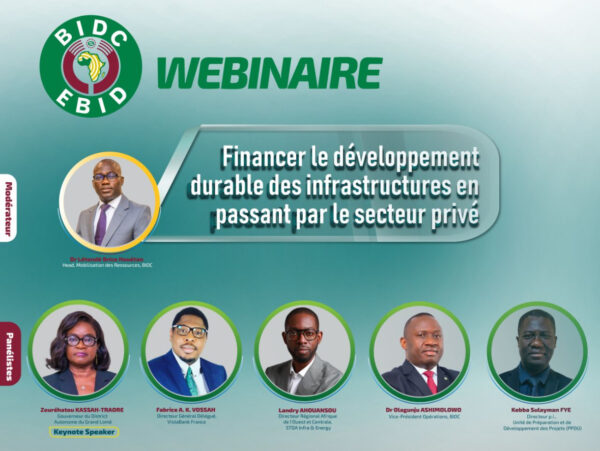The conclusions of the webinar organized on August 12, 2025 by the West African Development Bank (BIDC) call for a strategic realignment of infrastructure financing. The institution aims to make private capital, long considered peripheral, the central driving force behind a catch-up plan estimated at over $100 billion.
In West Africa, the infrastructure deficit is not just a physical delay—roads, ports, power grids—but a major hindrance to productivity, competitiveness, and regional integration. Entitled “Financing Sustainable Infrastructure Development by Mobilizing the Private Sector,” the webinar brought together public decision-makers, institutional investors, and development bankers. Experts analyzed the steps needed to turn this ambition into bankable and resilient projects.
Transitioning from Public to Mixed Capital
Introducing the conference, Dr. Brice Houeton, Senior Executive Banking and Investment Corporate at BIDC, lists the challenges in a context of multidimensional crisis, rapid demographic growth, and needs that have stretched the limits of public power in sustainable infrastructure financing. The situation is clear: “Relying solely on the State is no longer sustainable. A simultaneous mobilization of public, private, and multilateral actors is needed.”
Former Togolese Minister of Infrastructure Financing, Zouréatou Tchakondo-Kassa-Traoré, highlights a structural infrastructure deficit in ECOWAS. While Ghana and Côte d’Ivoire are among the 4 countries in the region with electrification rates around 70%, in most member states this rate is below 50%. Additionally, 50% of the region’s roads are neither developed nor paved, increasing the cost of access to the agricultural market. “According to studies, the infrastructure financing deficit in ECOWAS ranges from $50 to $100 billion annually.” Considering that the continent has spent $160 billion to service debt, it is clear that the money is there but needs to be structured. Private sector involvement is essential to bridge the gap.
Commercial banks work with short-term resources, incompatible with the long cycles of infrastructure. “Mobilizing saved savings and channeling them into long-term instruments is imperative. Pension funds can play a decisive role, provided they change their paradigm.”
Returning to the floor, Dr. Olagunju Ashimolowo, Vice President of BIDC, confirms the West African gap. “We are seeing increasing demand for infrastructure financing and, on the other hand, a decreasing availability of public funds.”
De-risking before investing
Participating in the webinar, Kebba Faye, Acting Director, Project Preparation and Development Unit at ECOWAS, quantifies the equation: “The billions of dollars in deficit will not be filled without unlocking the potential of domestic investment. This requires structured de-risking mechanisms: regional insurance, public guarantees, mixed financing vehicles.”
The banker advocates for an ECOWAS guarantee mechanism to reassure investors against political and operational risks. On the other hand, Landry Ahouansou, Director of Investments at STOA Infra & Energy, believes governance is key: “Governance, governance, governance. A state with an impeccable repayment history inspires more confidence than an over-guaranteed state in default.”
Among the tools mentioned: issuing infrastructure bonds in local currency to mobilize domestic savings while limiting exposure to currency risk.
Regional Integration: a Lever for Bankability
Fabrice Vossah from Vista Group highlights the example of UEMOA: “A single currency and an integrated market across eight countries already provide a comparative advantage. If ECOWAS extends this model to 16 states, the leverage effect on project bankability would be significant.” An expanded market would offer deeper liquidity pools, a more diversified investor base, and regional project portfolios attractive enough to attract large-scale private capital.
From Words to Action: BIDC as the Conductor
The diagnosis is shared: West Africa does not lack savings but lacks instruments to mobilize them. The region does not lack vision, but investable, secure projects backed by robust governance frameworks. In this architecture, BIDC aims to act as a structuring catalyst—aligning political will, regulatory reform, and financial innovation. Whether it’s infrastructure bonds, pension fund mobilization, regional insurance mechanisms, or ECOWAS guarantees, the goal is clear: to move private capital from the periphery to the heart of African infrastructure financing.


